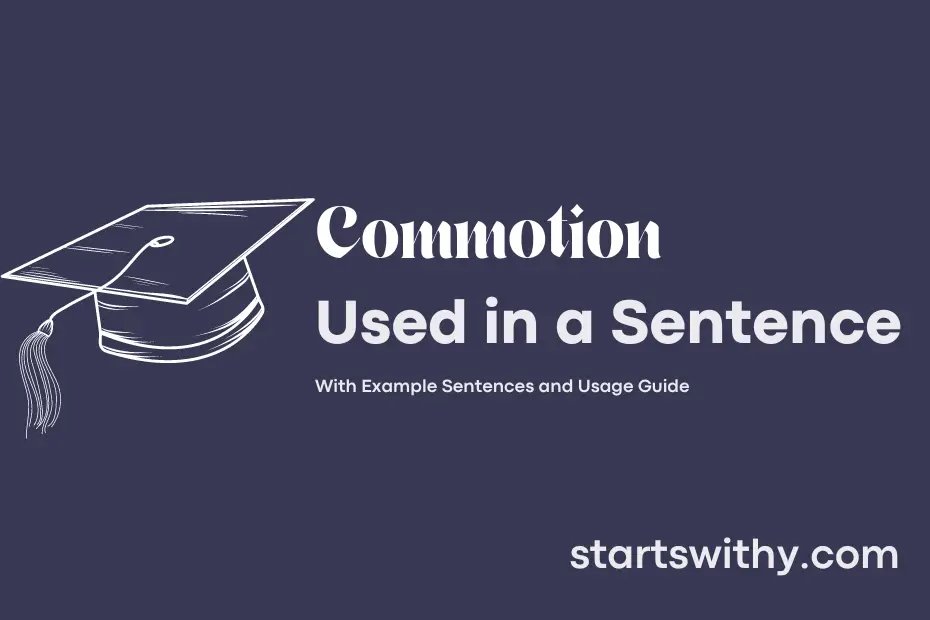Ever found yourself in a situation where there was a sudden uproar or disturbance? That chaotic scene is what we refer to as a “commotion.” A commotion is a noisy and disorderly state of affairs, often characterized by confusion and a lack of calm.
A commotion can arise in various settings, from a crowded marketplace to a heated argument in a classroom. It typically involves a disturbance that grabs attention and disrupts the normal flow of things. Throughout history, literature and films have showcased dramatic scenes filled with commotion, adding intensity and intrigue to the narrative.
7 Examples Of Commotion Used In a Sentence For Kids
- Commotion is a lot of noise and movement.
- Sometimes, there is commotion when people are excited or scared.
- Commotion can happen when a lot of people are talking at the same time.
- It’s important to stay calm during a commotion.
- When there’s a commotion, it can be hard to hear what others are saying.
- Commotion in the classroom can disrupt learning.
- Let’s try to reduce commotion so we can focus on our work.
14 Sentences with Commotion Examples
- There was a commotion outside the college library as students protested against the increase in tuition fees.
- The sudden commotion in the cafeteria left everyone wondering what had caused the disturbance.
- The commotion during the lecture made it difficult to concentrate on the professor’s explanation.
- Students rushed out of the classroom, causing a commotion in the hallway.
- The announcement of a surprise test created quite a commotion among the students.
- The loud commotion from the sports field distracted students studying in the nearby classrooms.
- The arrival of a celebrity on campus caused a commotion as students gathered around to catch a glimpse.
- The unexpected power outage led to a commotion as students tried to find their way out of the darkened lecture hall.
- The cancellation of a popular event sparked a commotion among disappointed students.
- The discovery of a snake on campus caused a commotion as students and faculty members tried to capture it safely.
- A fight between two students in the cafeteria created a commotion that quickly drew a crowd.
- The sudden announcement of a new college policy caused a commotion among students who felt blindsided by the change.
- A protest by student activists outside the administrative building led to a commotion as security tried to maintain order.
- The annual college fest always brought a joyful commotion to campus as students participated in various events and activities.
How To Use Commotion in Sentences?
To use the word Commotion in a sentence, first identify a situation where there is a lot of noise, confusion, or excitement. Then, incorporate the word into your sentence as follows:
Example sentences:
1. The arrival of the celebrity caused a sudden commotion among the crowd, with everyone clamoring to get a glimpse of them.
2. In the midst of the busy market, a loud commotion broke out as two vendors argued over a customer.
3. The unexpected announcement created a commotion in the office, with employees rushing to find out more information.
When constructing a sentence with Commotion, ensure that it accurately conveys a sense of disturbance or disruption in a certain environment. By using the word effectively in different contexts, you can improve your proficiency in incorporating it into your vocabulary. Practice forming sentences with Commotion in various scenarios to become more comfortable with its usage and better articulate situations that involve chaos or noise. Remember to pay attention to the context in which you use the word, and consider the tone you wish to convey through your sentence.
Conclusion
In conclusion, the use of sentences with “commotion” can effectively describe chaotic or loud situations, where there is a sense of confusion or disturbance. These sentences vividly portray a scene filled with uproar, disturbance, or agitation, creating a sense of urgency or tension within the writing. By incorporating such sentences, writers can effectively convey the atmosphere of a bustling or tumultuous setting to their readers.
Furthermore, sentences with “commotion” serve as powerful tools to engage readers and immerse them in the narrative by vividly depicting moments of chaos or disruption. Whether describing a crowded street, a noisy party, or a heated argument, these sentences add depth and intensity to the writing, leaving a lasting impact on the audience and enhancing the overall reading experience.



